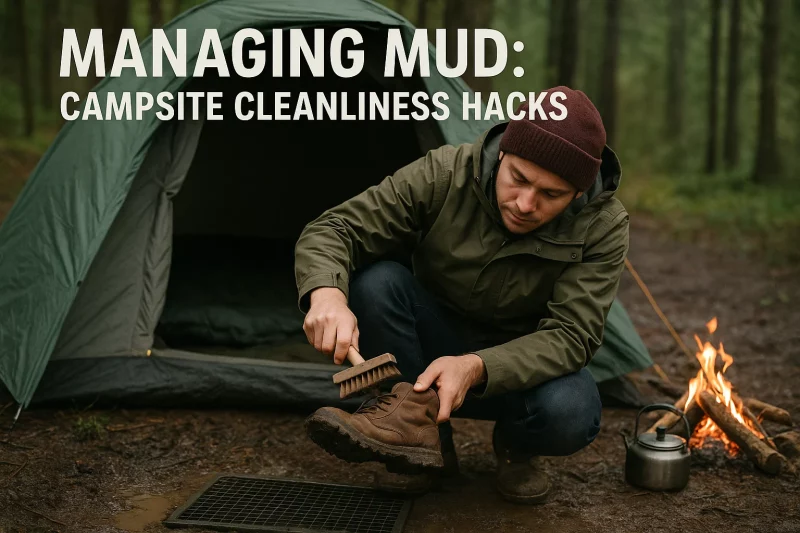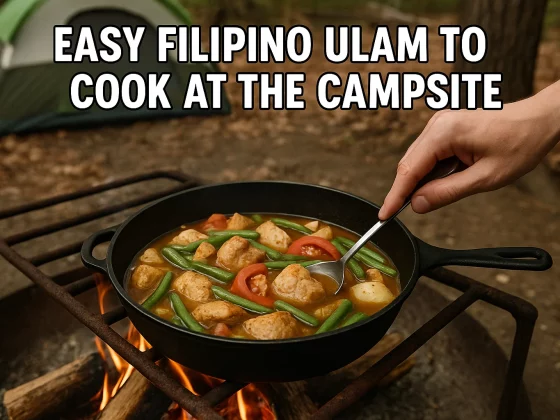Camping in the Philippines often means facing unpredictable weather—one moment it’s sunny, and the next, rain showers turn the ground into a muddy mess. While a bit of dirt is part of the outdoor experience, excessive mud can make everything slippery, sticky, and uncomfortable. It clings to your tent, seeps into your shoes, and coats your gear before you even realize it.
Still, mud doesn’t have to ruin your adventure. With a few clever campsite cleanliness hacks, you can keep your area tidy, your gear dry, and your experience stress-free. These practical tips will help you stay organized and comfortable even when the ground beneath you turns into a swamp.
Understanding Mud: Why It’s a Camper’s Challenge
Mud forms when water saturates loose soil, which is common in forested or riverside campsites. Philippine terrain—rich in clay and organic matter—can hold moisture for hours, making even a brief rain shower a potential hassle.
It’s not just about mess. Mud can affect traction, make setting up tents difficult, and even attract insects. Managing it efficiently requires a mix of smart setup, preventive measures, and creative cleaning tricks.
Choose the Right Campsite Location
The best way to avoid mud problems starts before you pitch your tent. When scouting a campsite, look for slightly elevated ground instead of low-lying areas where water naturally collects. A few meters of elevation can make a huge difference in how dry your area stays after rainfall.
Avoid camping too close to rivers, lakes, or trails where water and mud are likely to flow. Dense grass or ground cover helps absorb moisture better than bare soil, so try to position your tent over vegetation whenever possible.
If your chosen campsite is already wet, create shallow trenches around your tent to redirect water flow. Just be sure to follow Leave No Trace principles and fill them back before leaving.
Use a Groundsheet or Tarp Barrier
A waterproof barrier is your first line of defense against mud. Place a tarp or groundsheet under your tent to prevent water from seeping in. Let the edges tuck slightly under the tent floor to keep rain from collecting on top of it.
You can also use an extra tarp at the entrance of your tent as a mud mat. This makes a perfect spot for removing muddy shoes before stepping inside. For added comfort, line the interior of your tent with a thin foam mat or old blanket—this helps contain dirt in one area, making cleanup easier.
If you plan to cook outdoors, extend another tarp or canopy over your cooking zone. It shields your gear from rain splashes and gives you a clean, dry space to prepare meals. You can even hang a lantern or clothesline underneath it to maximize utility.
Pack a Reliable Cooking Setup
Rain and mud can make outdoor cooking tricky. Setting your stove on uneven, wet ground risks both spills and accidents. That’s why having a stable and efficient cooking tool is essential.
Consider upgrading to a portable, weather-resistant stove like the superkalan burner. Compact yet powerful, it works well even on damp terrain, ensuring that your meals cook evenly regardless of the conditions. Its sturdy design prevents tipping and keeps the flame steady against wind and drizzle.
Pair it with a lightweight cooking table or a wooden board to create a flat, clean surface. This setup keeps your cookware from sinking into the mud and allows you to maintain cleanliness while preparing food.
Keep a Foot-Cleaning Station by Your Tent
One of the biggest sources of campsite mess is mud tracked into the tent. Solve this by setting up a dedicated “mud station.” Place a small basin or bucket near your tent door, fill it with water, and use it to rinse muddy shoes and feet.
Keep a small mat or towel next to it for drying off before entering. You can also repurpose an old shoe rack or crate to store wet footwear separately. This simple habit drastically reduces dirt buildup inside your sleeping area.
If you’re camping in a group, designate a single entrance and exit path to minimize mud spread. Add stones or flattened wood planks along the walkway for traction.
Bring Quick-Dry and Waterproof Gear
When camping during the rainy season, materials matter. Choose quick-dry clothing, microfiber towels, and waterproof bags to make post-rain cleanup easier. Avoid heavy fabrics that absorb moisture.
Store all your electronics and essentials in dry bags or plastic containers. Even if your tent stays dry, mud splatter can ruin delicate gear. For cooking and eating, bring reusable silicone mats or collapsible bowls that can be rinsed easily.
If you expect prolonged rain, pack extra tarps to cover your cooking area and seating spot. A waterproof canopy also doubles as a communal shelter for dining or lounging without dealing with muddy ground.
Cleaning Tricks for Muddy Gear
Mud doesn’t have to be permanent. Once it dries, it’s much easier to remove. Shake or brush off the dried dirt from your shoes, mats, or tent exterior before rinsing them. Avoid scrubbing wet mud—it spreads and creates stains.
For cookware, wipe off any grit before washing. Use biodegradable soap and a sponge designated for camp use. If your towel or clothing gets muddy, rinse them first in a separate basin before mixing with cleaner water to avoid contamination.
You can also pack a small spray bottle filled with diluted vinegar or soap solution to clean sticky surfaces or tables. Paper towels or old rags make quick cleanup less messy.
Elevate and Separate Your Belongings
The key to staying organized in muddy conditions is keeping things off the ground. Use crates, small stools, or hanging organizers to keep your gear elevated. Inside the tent, store essentials in sealed containers or bags rather than leaving them loose.
For extra protection, place a waterproof mat beneath your sleeping bags and keep clothes in individual zip pouches. When the ground is wet, even small habits like hanging your backpack on a tree branch can make a big difference.
If camping with a vehicle, use the back of your car as a makeshift storage and prep area. It helps minimize contact with wet ground while giving you a cleaner workspace.
Drying Out After the Rain
Once the skies clear, drying your gear properly prevents mildew and odors. Hang wet items on a clothesline or over your tarp shelter to air out. Avoid placing them directly on muddy surfaces.
If sunlight is scarce, wring items thoroughly and use airflow to speed up drying—battery-operated fans or open-tent ventilation help a lot. Shake out sleeping bags and mats before packing to remove residual dirt.
Before heading home, pack dirty gear separately in sealed plastic bags so it doesn’t contaminate clean items. Once home, wash and fully dry everything before storage to prevent mold growth.
Eco-Friendly Mud Management
It’s important to manage mud without harming the environment. Avoid digging deep trenches or using chemical cleaners that can seep into the soil. Use biodegradable soaps and natural disinfectants like vinegar for cleanup.
If you’re camping near natural water sources, do your washing at least 50 meters away to prevent contamination. Dispose of wastewater responsibly, scattering it over a wide area instead of pouring it all in one spot.
By staying eco-conscious, you ensure that the campsite remains beautiful for future campers.
Group Cleanliness Etiquette
If camping with friends, assign simple cleanup roles. One can handle the cooking area, another the tent zone, and someone else the foot-cleaning station. This teamwork prevents chaos and keeps everyone comfortable.
Encourage everyone to follow the “no shoes in tent” rule and keep personal trash bags. Establishing cleanliness routines from the start saves time later and keeps the mood light even when things get muddy.
Final Thoughts: Stay Grounded, Not Dirty
Mud is part of the adventure, but it doesn’t have to define your camping experience. With preparation, smart gear choices, and good organization, you can manage even the messiest campsite.
A few extra tools—a reliable tarp, a basin, and a sturdy superkalan burner—can make all the difference between chaos and comfort. By keeping things dry, elevated, and clean, you’ll not only extend the life of your gear but also make your trip far more enjoyable.
At the end of the day, camping is about embracing nature while respecting it. Staying tidy helps you do both. So the next time the ground turns muddy, remember: a little dirt won’t stop a well-prepared camper.



